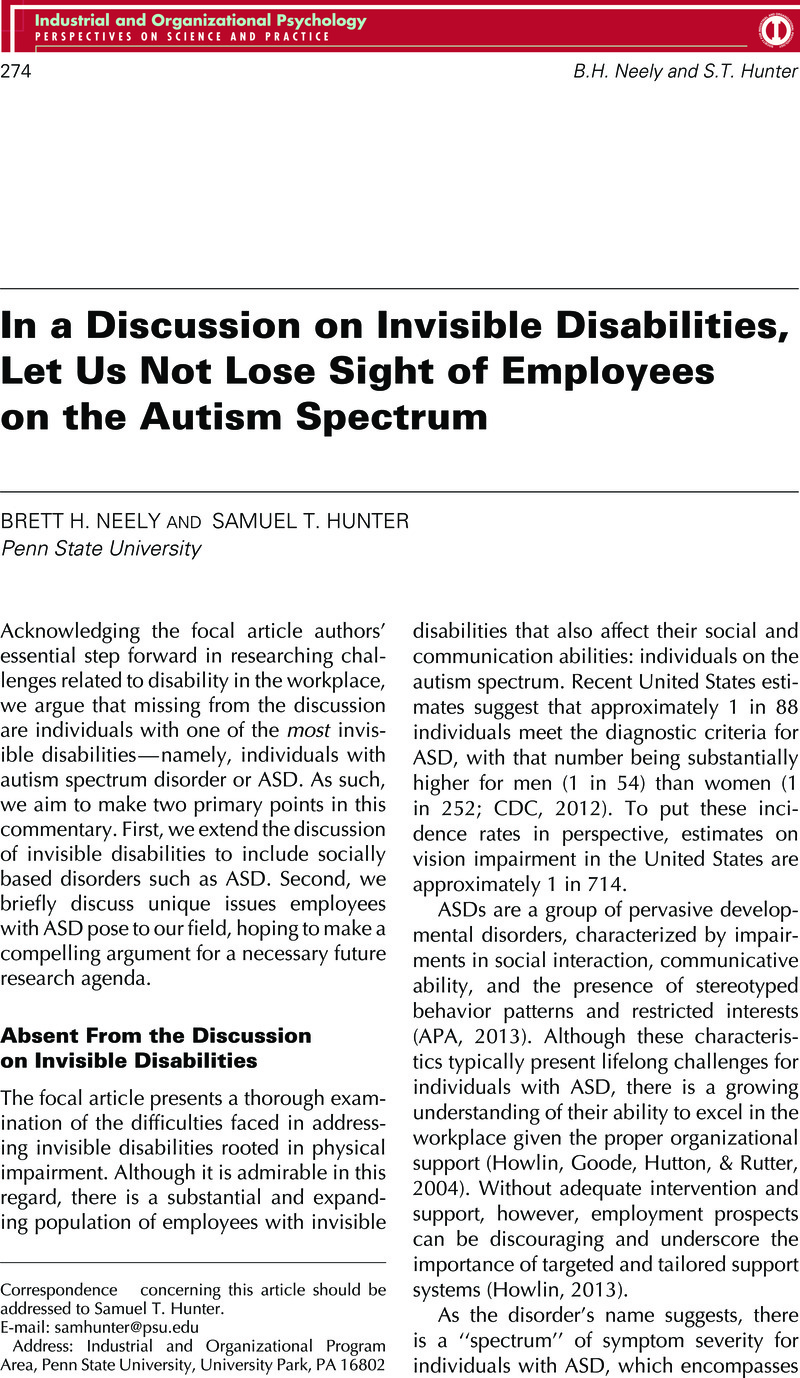Crossref Citations
This article has been cited by the following publications. This list is generated based on data provided by Crossref.
Ohl, Alisha
Grice Sheff, Mira
Small, Sarah
Nguyen, Jamie
Paskor, Kelly
and
Zanjirian, Aliza
2017.
Predictors of employment status among adults with Autism Spectrum Disorder.
Work,
Vol. 56,
Issue. 2,
p.
345.
Brownlow, Charlotte
Werth, Shalene
and
Keefe, Kathleen
2018.
Work and Identity.
p.
23.
Fardella, Michelle A.
Burnham Riosa, Priscilla
and
Weiss, Jonathan A.
2018.
A qualitative investigation of risk and protective factors for interpersonal violence in adults on the autism spectrum.
Disability & Society,
Vol. 33,
Issue. 9,
p.
1460.
van den Bosch, Karin E.
Krzeminska, Anna
Song, Eun Young
van Hal, Lineke B. E.
Waltz, Mitzi M.
Ebben, Hannah
and
Schippers, Alice P.
2019.
Nothing about us, without us: A case study of a consumer-run organization by and for people on the autism spectrum in the Netherlands.
Journal of Management & Organization,
Vol. 25,
Issue. 04,
p.
464.
Hurley-Hanson, Amy E.
Giannantonio, Cristina M.
and
Griffiths, Amy Jane
2020.
Autism in the Workplace.
p.
21.
EFEOĞLU, İ̇brahim Efe
and
KILINÇARSLAN, Ömür
2020.
Otizmli Bireylerin İstihdamında Örgüt Desteğinin Rolü.
OPUS Uluslararası Toplum Araştırmaları Dergisi,
Vol. 16,
Issue. 29 Ekim Özel Sayısı,
p.
1.
Whelpley, Christopher E.
Banks, George C.
Bochantin, Jaime E.
and
Sandoval, Rosalyn
2021.
Tensions on the spectrum: an inductive investigation of employee and manager experiences of autism.
Journal of Business and Psychology,
Vol. 36,
Issue. 2,
p.
283.
Mallipeddi, Nathan V.
and
VanDaalen, Rachel A.
2022.
Intersectionality Within Critical Autism Studies: A Narrative Review.
Autism in Adulthood,
Vol. 4,
Issue. 4,
p.
281.
Zheng, Lidan
Foley, Kitty-Rose
Grove, Rachel
Elley, Kieran
Brown, Scott Andrew
Leong, Dawn-joy
Li, Xue
Pellicano, Elizabeth
Trollor, Julian N
and
Hwang, Ye In (Jane)
2022.
The use of everyday and assistive technology in the lives of older autistic adults.
Autism,
Vol. 26,
Issue. 6,
p.
1550.
Whelpley, Christopher E.
and
May, Cynthia P.
2023.
Seeing is Disliking: Evidence of Bias Against Individuals with Autism Spectrum Disorder in Traditional Job Interviews.
Journal of Autism and Developmental Disorders,
Vol. 53,
Issue. 4,
p.
1363.
Hutson, J.
and
Hutson, P.
2023.
Digital Inclusion for People with Autism Spectrum Disorders: Review of the Current Legal Models and Doctrinal Concepts.
Journal of Digital Technologies and Law,
Vol. 1,
Issue. 4,
p.
851.
Cárcamo, Benjamin
2023.
La representación de la aprobación de la ley TEA: un análisis multimodal de las noticias en periódicos digitales chilenos.
Lengua y Sociedad,
Vol. 22,
Issue. 2,
p.
397.
Trundle, Grace
Jones, Katy A.
Ropar, Danielle
and
Egan, Vincent
2023.
Prevalence of Victimisation in Autistic Individuals: A Systematic Review and Meta-Analysis.
Trauma, Violence, & Abuse,
Vol. 24,
Issue. 4,
p.
2282.
Giannantonio, Cristina M.
Hurley-Hanson, Amy E.
and
Griffiths, Amy Jane
2024.
Neurodiversity and Work.
p.
157.
Ezerins, Maira E.
Simon, Lauren S.
Vogus, Timothy J.
Gabriel, Allison S.
Calderwood, Charles
and
Rosen, Christopher C.
2024.
Autism and Employment: A Review of the “New Frontier” of Diversity Research.
Journal of Management,
Vol. 50,
Issue. 3,
p.
1102.





